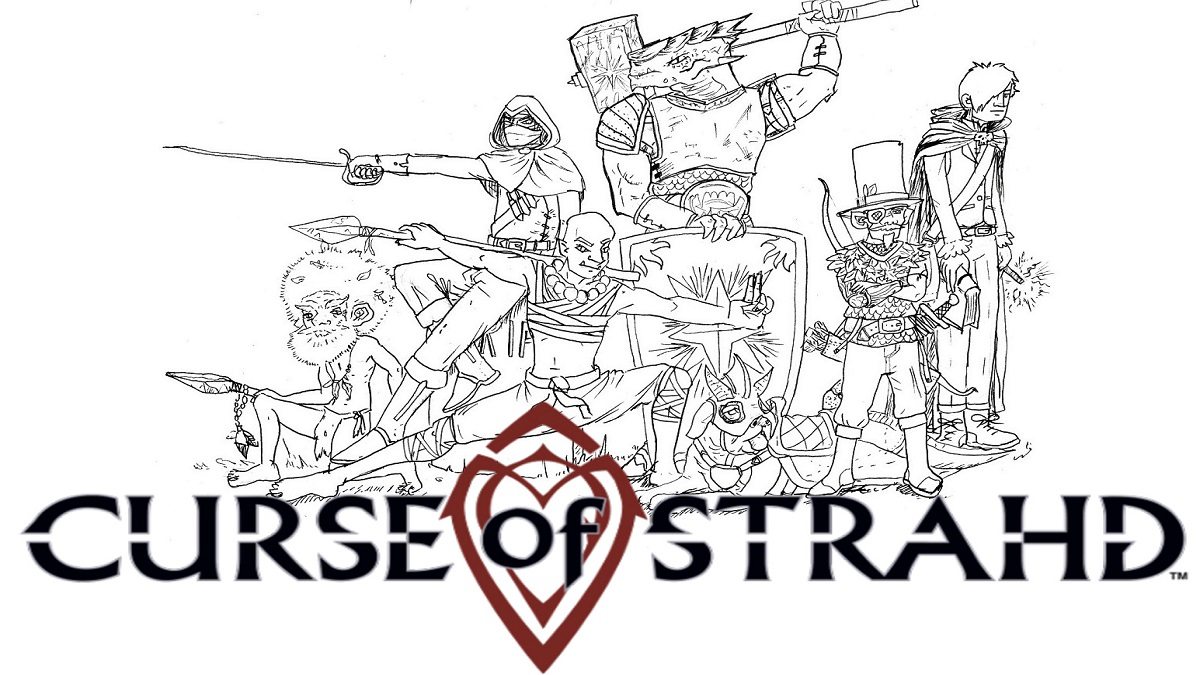Can music theory be fun? Many of the terms from music theory are just begging to be made into hilarious puns. What if you could learn music theory while playing a game? Of course, what could be geekier than a tabletop game about music theory? Lord of the Chords answers this call.
What Is Lord of the Chords?
Lord of the Chords is a game for 2-4 players, ages and 14 and up, and takes about 45 minutes to play. It’s currently seeking funding for its second edition on Kickstarter, with a pledge level of $38 for a copy of the base game. The Major Edition of the game includes the base game as well as an expansion pack and piano box for carrying the game can be had for a $55 pledge.
Lord of the Chords was designed by Jonathan Ng Kin Hou, Keith Teo Rong Jun, and Phang Jun Yu and published by Lord of the Chords LLP. The Kickstarter campaign is already underway and ends on October 22, 2020.
New to Kickstarter? Check out our crowdfunding primer.
Lord of the Chords Components
Note: My review is based on a First Edition copy of the game, so some of the cards and components may not represent what is being offered with the Second Edition. As a Kickstarter exclusive, all cards will have a foil effect.
- 52 Note Cards
- 44 Action Cards
- 13 Instrument Tiles
- 12 Key Signature Tiles
- 16 Tonality Indicator Picks
- 20 Accidental Tokens with cloth bag
- 52 Expansion Cards (Major Edition and higher)
- Piano Box (Major Edition and higher)
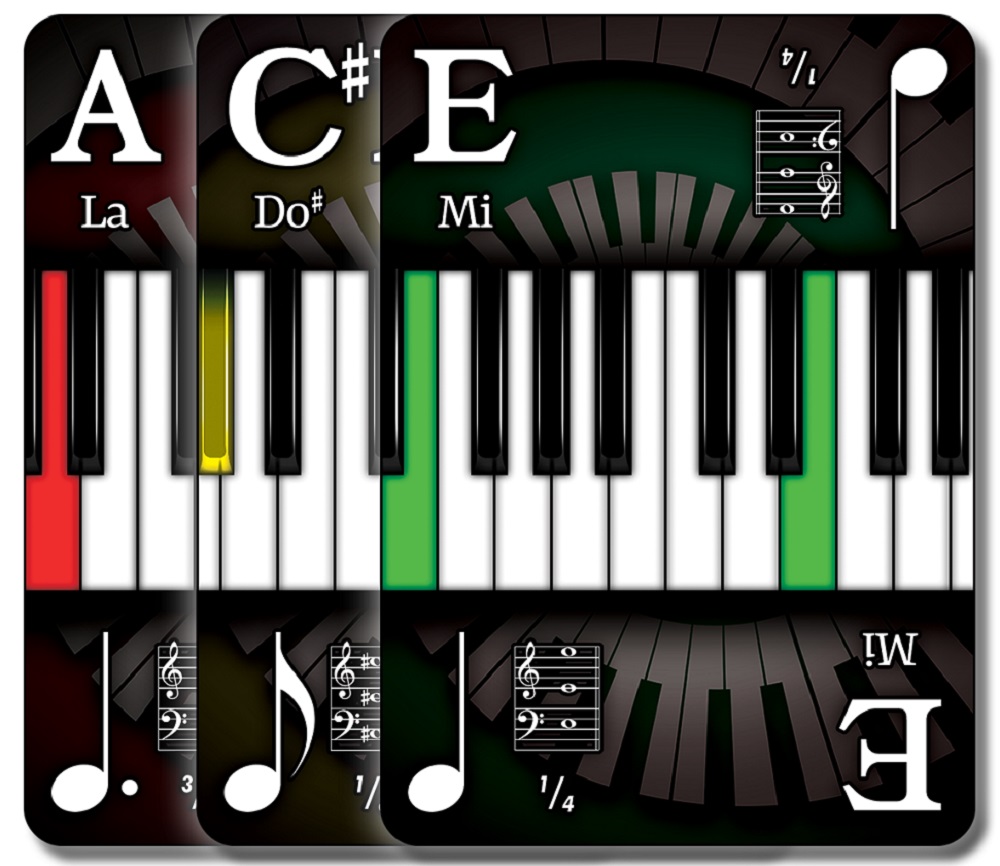
Note cards are used to collect the key signature tiles. Players can draw note cards from the river to add to their hand and then play them to their field to create chords. They can also be exchanged for accidental tokens.

Action cards allow players to take a variety of actions such as drawing more cards, stealing other player’s completed chords, preventing other players from playing an action card, and much more. Action cards help keep the players engaged and can even add a ‘take that’ aspect to the game.

At the start of the game, each player chooses an instrument tile that gives a special ability called a solo to that player. The Bass lets that player draw two accidental tokens for free whenever they complete a chord. Guitar lets the player collect chords by playing power chords. The Harp lets a player move notes around the field without costing a move. Instruments provide variety to the game.
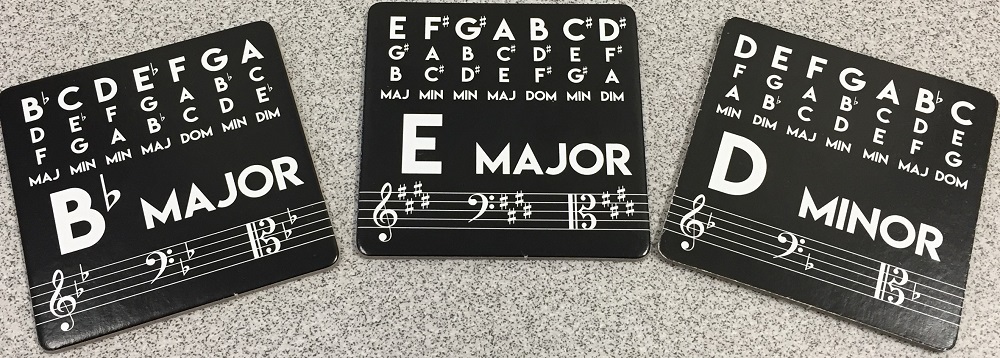
Key signature tiles are what players are trying to collect. To collect one, a player must play the the three note cards that match one of the 7 chords listed on the key signature tile.

After collecting a key signature tile, place a tonality pick on it to designate it as a major, minor, or dominant chord. These help when playing 7th Steal cards to steal chords. The picks can also show if a key signature tile is immune from stealing.
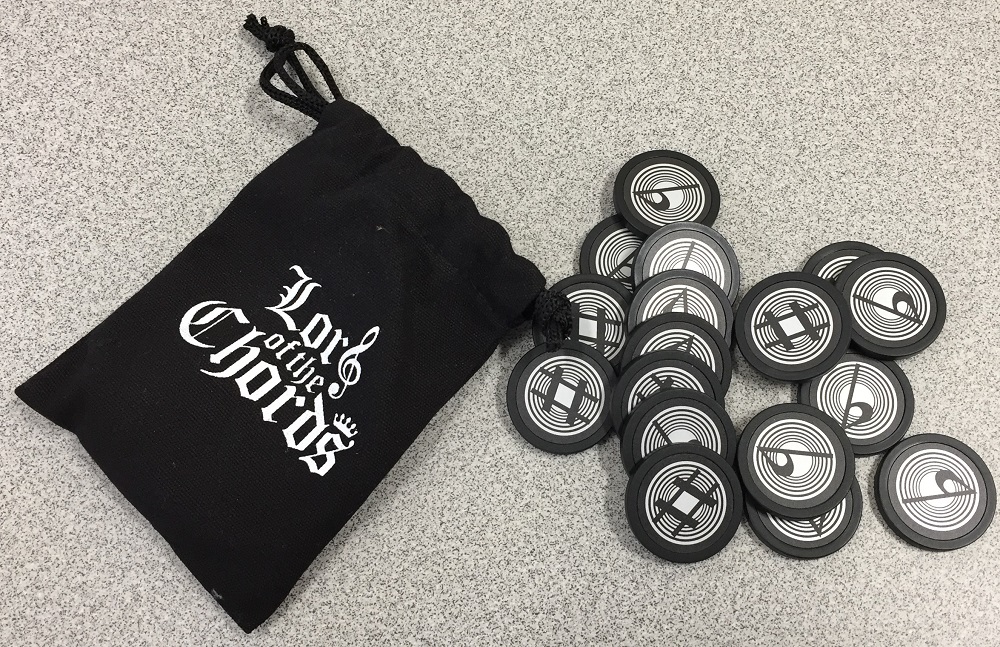
Play an accidental token onto a note card as you play that card to change the resultant pitch. One side of the accidental token has a sharp symbol while the other side has a flat symbol. For example, if you play the sharp side of the token on an A note card, it changes it to an A sharp. Or if you played the flat side onto a G sharp note card, it would change the card to a G. A cloth bag is included for storying the tokens.
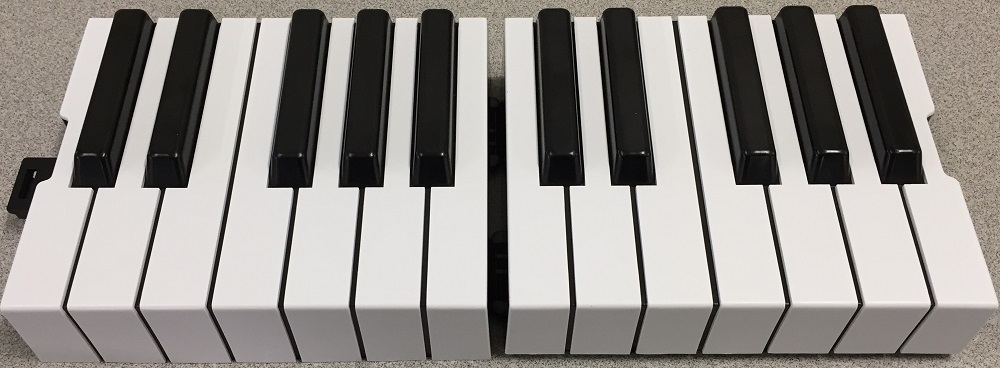
The piano box and expansion cards are not included in the base game. The piano box can hold all of the game pieces and makes it more convenient to take Lord of the Chords with you on the go. The expansion cards include 42 new action cards and 10 style cards in five different packs. The first pack, Advanced Chords, allows you to play extensions to get buffs. The Composer pack has more puns with the names of composers. The Modulation pack lets you form cadences to score more points, thus adding a higher level of music theory. The Essentials pack adds Equip cards which you can add to your instrument for additional perks. Finally, the Conductor pack introduces Styles. When playing with Style, two of these cards are selected and remain in play for the entire game. They make minor rule changes that affect everyone.
How to Play Lord of the Chords
You can download a copy of the rulebook here.
The Goal
The goal of the game is to be the first first player to collect three Key Signature Tiles and become the Lord of the Chords.
Setup
Setup is quick and easy. First players select which key signature tile they will be playing for and place it on top of the other tiles to create a deck. Each player collects one accidental token and place the remainder in a pile on the table. Next each player selects one of the instrument tiles which they will use for the entire game. Shuffle the note cards into a deck and draw three cards and place them face up to create the river. Next shuffle the action cards into a deck and place three face up action cards into the river. Place the decks to the left of the river. The discard pile for each deck is directly to the left of the deck. You are now ready to play.

Gameplay
Lord of the Chords is played in turns. The player who practiced an instrument most recently goes first and then play continues to the player on the left. A turn is divided into the draw phase and the play phase. During each player’s draw phase, they draw a total of three cards from either or both of the rivers. For example, a player may draw two note cards and then an action card. After the draw phase is concluded, the rivers are refilled and the play phase begins. The player now has three moves. There are four actions which each cost a move. A player can play a note card to their field where they are trying to build chords. A player can also play an action card. Once played, it is placed on the discard pile. A player may move a note card from one chord to another in their field. A player can also trade in note cards in exchange for accidental tokens. Each token costs a dotted quarter note. During an exchange, a player can exchange as many note cards for as many tokens as they can afford. For example, and 1/8 note and a 1/4 note would get a player one token as would a 1/2 note (any overages are lost). A 1/4 note and a 1/2 note could exchange for 2 tokens. Finally, a player can use two of their moves to draw a card from the river.

Players are trying to form one of the chords on the key signature tile in order to claim it. They may be trying to complete more than one chord at a time in their field. Once a chord has been completed, the player takes the key signature tile and places it on the chord to show it is completed. Then place a tonality pick to show if it is a major, minor, or dominant chord. These are listed below each chord on the key signature tile. If it is a diminutive chord, then you can place a steal immunity pick on it since diminutive chords cannot be stolen. Now the player who collected the key signature tile gets to pick which tile will be next. Once the new key signature tile is selected, players must then discard any note cards in their field that are off key for the new key signature. For example, if the new key signature were D Major, any of the notes, such as F, C, or G sharp would be off key and discarded. You can also discard a token from a note card instead if that will keep it in key.
For the first game or two, Lord of the Chords recommends players play with only note cards and accidental tokens so players can focus on learning how to create chords. Once they are familiar with the chords, the add in action cards. These can really change the game. Rest card are played against other players and forces them to skip one or more moves during their turn. Some cards let you draw more cards from the river, the deck, or even the discard pile depending on the action card. Time signature cards allow you to draw cards from the deck one at a time until the total value of the note cards exceeds the time signature on the card. This provides a push your luck action to the game. You only get to keep the cards you draw if you stop before exceeding the time signature. Scale degree cards can be played as note cards and can change note depending on the current key signature tile. Chopin can separate a completed chord and the force that player to discard any notes that are not in key with the current key signature tile. This can result in them losing their key signature tile and putting it back in the deck. There are also Turn Down cards which can cancel another player’s action card when it is played. Some cards such as Turn Down cards can be played at any time and are called surprise cards.
Stealing is a way to take away someone’s completed chord and making it your own. There are six steal cards in the action deck. Two allow you to steal major chords, two can steal minor chords, and two can steal dominate chords. In order to play a steal card, you must be able to add a note card to a completed chord to make it a 7th chord. For example, for the D Major key signature chord in the image above, adding an E note card to the end of the chord makes it a 7th. It can now be stolen with a 7th Minor Steal card since it is a minor chord. To make a chord immune from stealing, add a note card to make it an octave. Using the image above as an example, adding an F sharp to the completed chord prevents it from being stolen. It is usually a good idea to leave out the steal cards until players are familiar with using the other action cards.
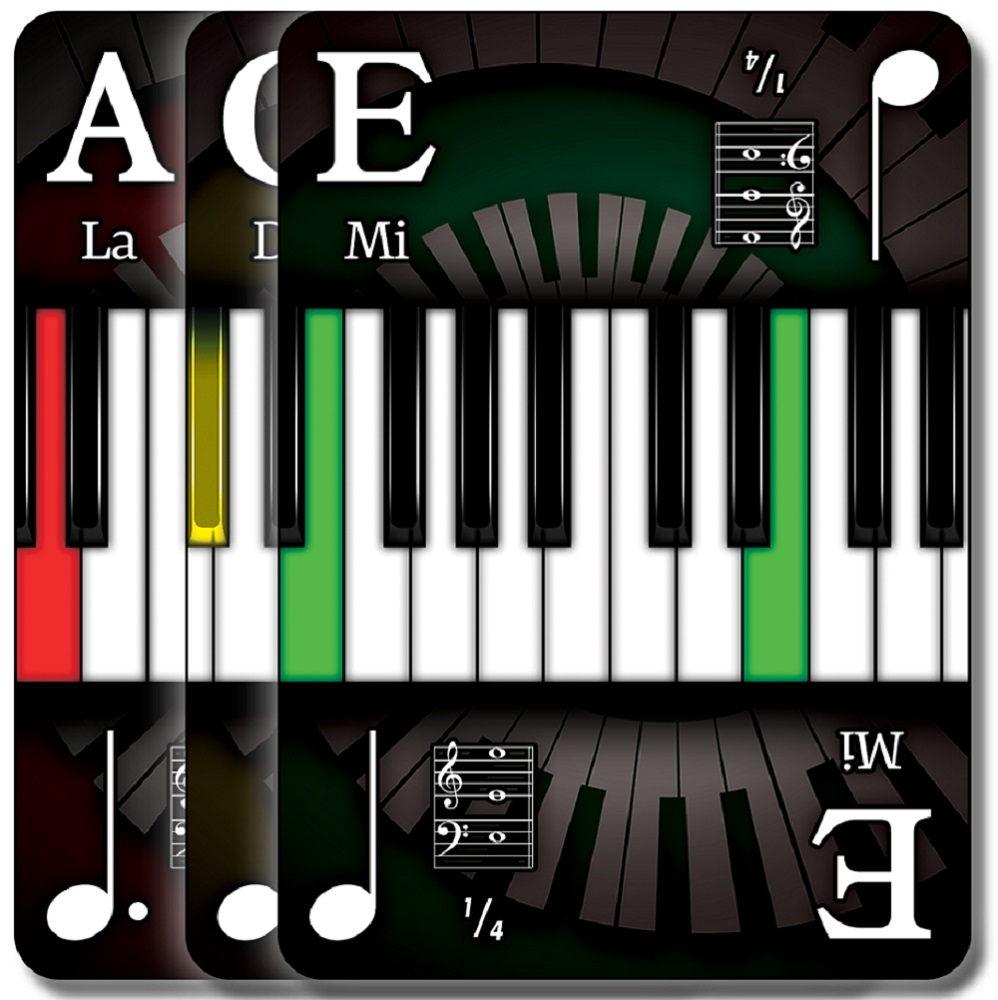
If the note deck is used up, shuffle the cards from the discard pile to create a new deck of note cards. However, once the deck of action cards is depleted, that’s it. No new action deck.
Game End
The game ends when when one player has collected three key signature tiles. As players are learning the game, you may only want to require collecting two key signature tiles for the win.
Why You Should Play Lord of the Chords

Lord of the Chords is definitely designed for certain types of players. It was designed by students of music theory and can be tough to learn for those with no music background. However, it can also be a great tool for helping teach music theory. My daughter who is a grad student in the vocal music program at a major university wants to use Lord of the Chords for some of the classes she teaches to help her students better learn music theory. The choir director at the high school where I teach, who also teachers AP music theory classes, was impressed with the game as well.
My knowledge of music theory is somewhat lacking. However, I played a few games of Lord of the Chords with other players with a limited knowledge of music. We all really enjoyed the game. Along the way, we learned a lot about music theory. My son, who is teaching himself piano with YouTube videos, was able to make connections between the game and his learning. At its base, Lord of the Chords is a card game. Creating chords is essentially making tricks of cards. While collecting key signature tiles is the objective of the game, in my opinion, the action cards are the real stars of the game. In my game plays, playing action cards were some of the most fun moments of the game. I was ready to collect the last key signature tile to win the game. I knew my daughter had a Chord Block card which would steal the last note card in my chord and prevent me from winning. However, I had a Turn Down card to prevent an action card played against me. My daughter was ready for this and played a Turn Down card of my own which canceled my Turn Down card. My son ended up winning that game.
Lord of the Chords is not for everyone. Those who enjoy music theory or sing or play instruments will have fun playing this game. Plus the creators of this game went to the extreme in creating puns for many of the action cards. Players who enjoy card games and are not afraid of learning some music theory will also enjoy it. If you have never heard of a dotted quarter note or know what a chord is, this may not be the game for you. However, I recommend Lord of the Chords to those with even a faint interest in music who would like to learn more while having fun.
For more information or to make a pledge, visit the Lord of the Chords Kickstarter page! The campaign ends October 22, 2020, so don’t delay.
Click here to see all our tabletop game reviews.
![]() To subscribe to GeekDad’s tabletop gaming coverage, please copy this link and add it to your RSS reader.
To subscribe to GeekDad’s tabletop gaming coverage, please copy this link and add it to your RSS reader.
Disclosure: GeekDad received a copy of the First Edition of this game for review purposes.



